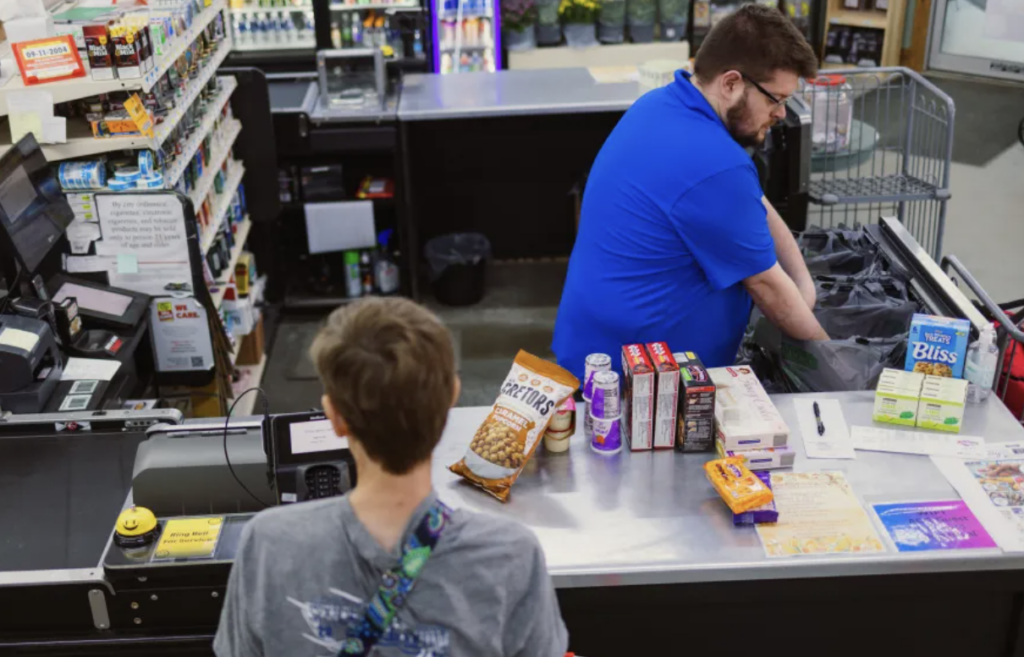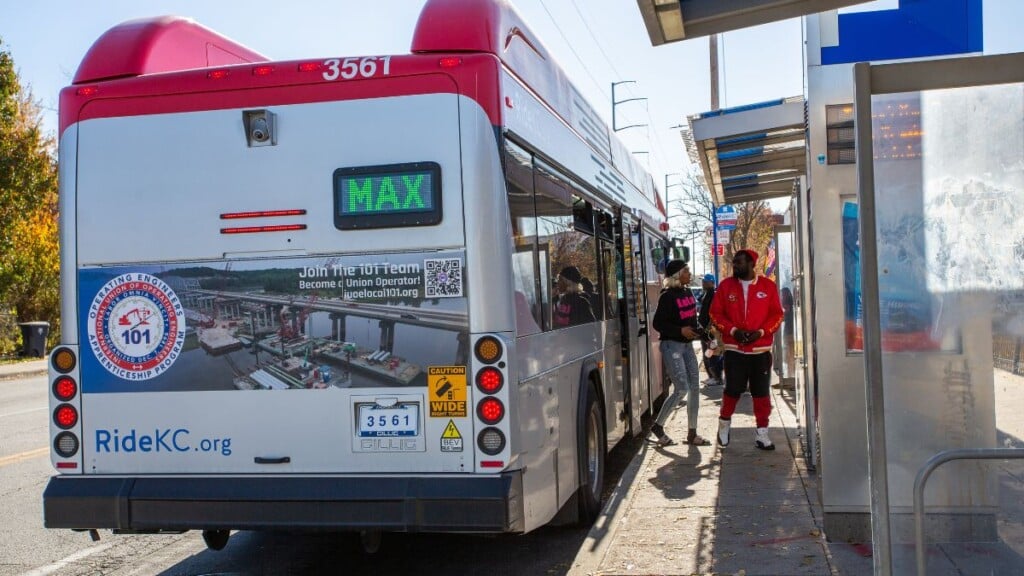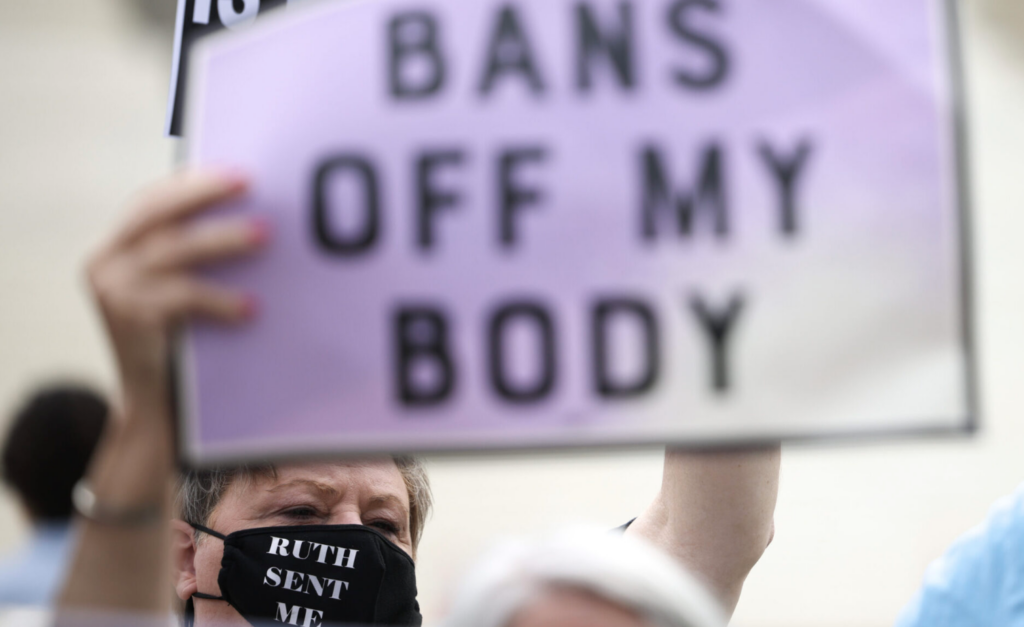KC’s workers struggle with inflation amid affordability crisis
While workers produce more than ever, rising costs for food, housing, child care, and health care outpace wage growth, forcing Kansas City families into tough choices.

The cost of essentials is increasingly out of reach for many Kansas City families as costs outpace wages. (Naomi O’Donnell/The Beacon)
Chris Myers is a federal employee who was working without a paycheck during the government shutdown. The former co-owner of Crane Brewing swallowed his pride to buy reduced-priced $6 meals at a local grocery store to stretch the family budget at an uncertain moment.
What happened when he went to pay at the counter left him slack-jawed.
Takeaways
- About half of families don’t earn enough to cover their bills and save for emergencies; forcing hard monthly choices between paying rent, buying groceries, affording child care, or seeking medical care.
- The costs of essentials like child care, housing, groceries and health insurance have outpaced wage growth in recent years.
- Rapidly rising employer health insurance costs are consuming money that might otherwise go to wage increases so workers face a double squeeze of stagnant paychecks and climbing out-of-pocket medical expenses.
The cashier told him that a stranger had already paid for hundreds of meals. Myers insisted on paying so someone even less fortunate could get a free dinner.
But the random act of kindness overwhelmed him.
“I just immediately started tearing up and almost had to step out of line,” Myers told The Beacon. “Sometimes you don’t realize you’re right on the edge until one more straw on the camel’s back. It just really hit, knowing how much that hopefully meant for people who are in even worse positions.”
The financial anxiety Myers describes is borne out by numbers that show that roughly half of us are struggling to make ends meet.
A new report from the Urban Institute found that 52% of American families earn less than what researchers call the “true cost of economic security” — meaning they don’t make enough to cover all their regular bills, pay for necessities and still have money left over to save for emergencies. In Kansas that number is 46.9%, and in Missouri 48.6% of people are in a similar position.
“I think more people are living paycheck-to-paycheck than would like to admit it,” Myers said. “The cost of everything being more expensive is really tough.”
Rising costs coupled with stagnant wages are putting a squeeze on working people across the spectrum in Kansas City. The squeeze is reflected in the hard choices people are making as they grapple with higher costs for housing, groceries, health care and child care.

Brutal math
The most glaring reason for this burgeoning affordability crisis is that wages have not grown as fast as prices for the basics working people buy.
The Urban Institute’s affordability tracker says that nationally, the average monthly grocery bill is up 32% while wages have only gone up 29% since 2019.
“I saw where a pound of ground beef was almost as expensive as the federal minimum wage,” Myers noted.
But it’s not just groceries.
Nationally, the rising cost of essentials from January 2017 to August 2025 outpaced wage growth during the same time period:
- The cost of child care for two children has risen 40%.
- Rent jumped 50%.
- Home sale prices have surged by 80%.
- And the lowest-priced “silver” plan on the health care marketplace went up by 41%.
Wages, meanwhile, only rose by 38%.
Locally, Kansas City-area workers are also paid less than workers in similar cities. According to the Mid-America Regional Council (MARC), average hourly earnings here run 15% to 20% below peer metros like Minneapolis and Denver.
Frank Lenk, MARC’s director of the Office of Economic Research, told the 2025 KC Economic Outlook event this month that the Kansas City labor market is weakening. He also noted that the area’s economic recovery from the COVID pandemic has been slower than in the rest of the U.S.
“This is a classic Kansas City story,” Lenk said. “We don’t bust as low. … But we don’t boom as high.”
Lenk said that economic boom times generally last longer than busts. In Kansas City that means with each boom-and-bust business cycle, the local economy falls further behind peer metros bit by bit.
Jeremy Hill, a regional economist for the Federal Reserve Bank of Kansas City, told the same group that lower wages in Kansas and Missouri also mean it’s harder to attract talent to the area.
“We don’t really have a labor problem, we have a wage problem,” Hill said.

Hill said that across sectors in Missouri and particularly in Kansas, businesses have higher expectations of productivity but often aren’t willing to pay higher wages for it.
When adjusted for inflation, average wages in Kansas have risen by just $20 a week between January 2017 and August 2025. Missouri has done slightly better with an average weekly pay increase of $30 during the same nearly nine-year period.
These small wage increases come during a time when workers are as productive as ever.

“This has been a trend for a long time in the U.S.,” University of Kansas economics Professor David Slusky told The Beacon. “A trend where… the amount of stuff a worker can make is growing more than workers’ wages each year.”
Slusky said the gap between productivity growth and wage growth means that while workers produce more value, they’re not seeing that value reflected in their paychecks.
Despite doing more than ever, area workers are losing buying power for basic necessities. This makes it increasingly difficult just to stay healthy, put food on the table, take care of your children or keep a roof over your head.
Housing price spikes
Megan Overfelt moved to Raytown, Missouri, hoping to save money before she bought a home in Johnson County, Kansas, where she grew up.
That was six years ago. She’s watched housing prices soar ever since.
“How do people get ahead in this kind of climate?” Overfelt said. “I was supposed to be here for a year or two to save money. … Now those hopes and dreams seem so far out of reach.”
Overfelt, a data entry worker in her 30s with four children, says her childhood home was approximately 1,500 square feet located in “not a big, fancy, rich part of Johnson County.” Last year it sold for $375,000.

According to data from the Greater Kansas City Regional Housing Partnership, nearly two out of three owner-occupied homes are valued at $300,000 or more in Johnson County. The average sale price in the county in October of this year was $465,000, according to Redfin.
“That’s insane to me, I don’t see how normal everyday working families can move up,” Overfelt said. “It’s like we are all just stuck.”
She considers herself lucky to have a landlord who has kept her rent below the median Raytown rent of $1,213 a month. She says she has neighbors with similar layouts who pay up to $1,700 a month.
“I’ve just kind of accepted that we might be renting forever,” Overfelt said.
Child care can cost a job
Marie H. is a single mother in her 20s who says she had to leave her job because she couldn’t afford child care.
“I’ve always made less than $20 an hour and the cheapest child care I could find was $250 a week,” she said. “I can’t find a job that pays enough to cover that and my other bills.”
Marie H. is a domestic violence survivor who is being referred to by an alias in this article for her safety. She said that after leaving a women’s shelter with her young child she’s taken to delivering food for income.
She brings her child along for deliveries, which saves her the expense of child care. Marie H. said that bends delivery app rules, but it is a risk she has to take. She told The Beacon that the gig work is inconsistent, meaning she’s working with no financial flexibility and most months she’s still falling behind.
Child care costs an average of $23,300 a year in Missouri and $24,400 in Kansas for two children. According to 2022 data from the U.S. Department of Labor, the cost of one infant’s care in Jackson County is the equivalent of 13.5% of median family income in the area.

Some parents opt out of the workforce in the face of ever-rising child care prices. The Center for American Progress estimated in 2019 that the national economy sees $57 billion a year in lost revenue, wages and productivity because of parents leaving the workforce.
Marie H. says that she has career goals and is working as much as she can, but her lack of affordable child care is holding her back.
“I’m willing to work, even as a cashier or at McDonald’s or something like that,” she said. “I just need the grace of somebody to help me with child care so I can get on my feet.”
Health care eating wages
Rising health care costs are another squeeze point for working families. While many in Kansas City dread the prospect of health care premiums doubling next year, growing health care costs are also quietly eroding wages.
Economics professor Slusky said total compensation — a measure that includes wages plus benefits like health care — has more closely tracked productivity than wages alone.
This means employers that provide health care are putting more money towards their employees’ health insurance each year, leaving less money available for wage increases if the employer doesn’t cut elsewhere.
“Health insurance is eating up a greater share of total compensation,” Slusky said.
Kansas City Federal Reserve Senior Vice President A. Lee Smith at the KC Economic Outlook event said that higher input costs are contributing to a job market cooling at the national level. Those higher costs are being driven, in part, by recent Trump administration tariffs and employer health care expenses.
“The employer cost of health benefits is up about 6% over the past year,” Smith said. “Which is a really high pace of increase relative to what we’ve seen over the past 10 years or so.”
Myers said his family’s health insurance premiums have nearly tripled over the past decade.
“We also just got notified that they’re going to decrease the amount they cover,” Myers said.
Overfelt says she can afford health insurance for herself through her employer but feels fortunate to receive some federal assistance for her children’s coverage.
“I have no idea what we would do otherwise, because insurance for families through most employers is more than half your paycheck,” Overfelt said.
Hard choices
For many, living close to the bone financially means choosing which bills to pay. Those hard choices show up in data that tracks financial distress.
Delinquent credit card debt has doubled since 2021 in both Kansas and Missouri. Now one in 20 people with a credit card in those states is 60 days or more behind on payments. The credit card delinquency increases coincide with when food prices began to jump.
Myers says his grocery budget has nearly doubled — from $200-$300 every other week at Costco to $400-$500 now.

The bigger change is restaurants.
“We almost never eat out anymore,” Myers said. “We cook pretty much everything at home.”
As a result, Myers has chef friends he doesn’t see as much anymore.
“I have to tell them: ‘I promise you I’m not ditching you or dodging you,” Myers said. “I still love you. I still love your food. I miss it. I just, it’s not something we can really do as much anymore.’”
Marie H. said she doesn’t have delinquent debt but she also hasn’t eaten a meal not made in her home for over a year. Financial sacrifices extend to her own health. She doesn’t even think about going to the doctor for herself.
“I basically make just enough to cover my car payment and rent,” Marie H. said. “I have zero left over for anything else.”
The crush over bills for the basics makes it even more difficult to save for a rainy day.
“I don’t think the concept of savings — no matter what level you’re on — is really a thing anymore,” Myers said.
Overfelt has made belt-tightening decisions for her family as expenses pile up. Some months that has meant canceling a subscription, and sometimes that has meant paying late or only a partial payment until the next paycheck.
“That’s kind of been this entire last year. It’s extremely rough financially just trying to keep up,” Overfelt said. “It’s definitely a juggle each month. A lot of that boils down to making sure that the kids are fed and they have a roof over their head.”
Slusky says the good news is that the resources to address the affordability crisis exist in America. The country’s overall wealth is at an all-time high — but it’s increasingly concentrated.
“The question is what more could be done… to help those least fortunate with these resources, while maintaining the incentive structure that produces that level of wealth,” Slusky said.
He emphasizes the need for predictable, sustainable public policy rather than dramatic changes that create uncertainty for both businesses and workers.
“The resources are there,” Slusky said. “We just need the political will to try to address these concerns.”
Until paychecks catch up or costs come down, about half of Kansas City will keep choosing between eating and healing, between saving and surviving.
“Whenever you’re in a situation like this, it’s 24/7,” Marie H. said. “It’s just work. Or stress about work. Or stress about money, with no break. Everyone deserves time to take a breath.”
This article first appeared on Beacon: Kansas City and is republished here under a Creative Commons Attribution-NoDerivatives 4.0 International License.![]()




